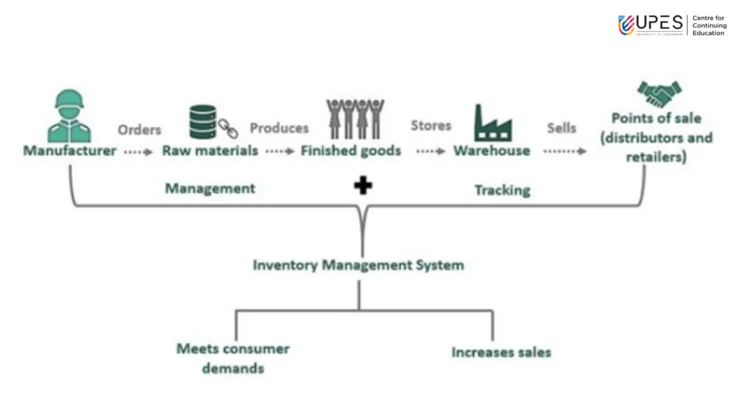Inventory Management: Ensuring Availability of Goods and Materials

Effective inventory management is essential for ensuring the smooth operation of any logistics and supply chain management business. Management of the movement and storage of items and resources is at the heart of inventory control.
A well-executed inventory management process can help minimize waste, reduce costs, and ensure products are available when needed. This outline will explore different types of inventory, inventory management techniques, challenges, and strategies for providing good inventory management.

In the above illustration, we can see essential parts and hierarchy staircase of the people, places and processes involved in the flow of inventory management. These processes are imperative to an inventory management system that ensures efficient deployment of resources to make sure availability of relevant and cost-effective goods and materials.
What is inventory management?
Inventory management refers to overseeing and controlling the movement and storage of goods and materials. An inventory management system can help businesses keep track of their inventory levels, sales, and deliveries.
Making sure the right products are available in the right amounts, at the right times, and for the right prices is the main goal of inventory management. Businesses that manage their inventories well can cut waste, boost customer happiness, and boost revenues.
We’ll go through the various kinds of inventory, inventory management methods, and strategies for assuring good inventory management in the sections that follow.
As the year approaches, the COVID-19 epidemic has the Indian economy in a crisis. India experienced its weakest growth in six years in the second quarter of FY20, with an annual growth rate of barely 4.5 percent.
Types of Inventory
A business can have several types of inventory. The three primary types are:
1. Raw materials
Raw materials are the primary materials used in the production of goods. Examples of raw materials include wood, metals, plastics, and textiles.
Therefore, effective management of raw materials inventory is crucial to ensure that the production process runs smoothly.
2. Work-in-progress
Work-in-progress (WIP) inventory refers to the goods that are currently in the process of being produced. This inventory includes partially completed products, materials waiting to be processed, and products waiting for quality control checks.
Proper management of WIP inventory is essential to ensure the timely completion of production orders.
3. Finished goods
The products that are prepared for sale are referred to as finished goods inventory. A finished goods inventory that is well-managed always has enough stock to satisfy customer demand while lowering the risk of overstocking.
In addition to the products mentioned above, a firm may also keep office supplies, maintenance and repair supplies, and packaging materials in its inventory.
Inventory Management Techniques
Effective inventory management in the supply chain involves using various techniques to ensure inventory levels are optimized while minimizing costs. Some standard inventory management techniques include:

1. Just-In-Time (JIT)
By only ordering or producing items when they are required, just-in-time (JIT) inventory management seeks to reduce inventory levels.
This approach helps reduce inventory carrying costs but also requires careful coordination with suppliers and can leave a business vulnerable to supply chain disruptions.
2. First-In-First-Out (FIFO)
First-in-first-out (FIFO) is a method of managing inventory in which the first items received or produced are the first to be sold or used. This approach helps to ensure that perishable items or those with expiration dates are sold before they expire.
3. Last-In-First-Out (LIFO)
Last-in-first-out (LIFO) is the opposite of FIFO, in which the most recently received or produced items are the first to be sold or used. This approach is helpful for businesses with short shelf life, as it helps ensure that the freshest products are sold first.
4. Economic Order Quantity (EOQ)
Economic order quantity (EOQ) is a mathematical formula to determine the optimal order quantity to minimize inventory carrying costs and ordering costs.
The EOQ considers factors such as the cost of goods, containing costs, and inventory carrying costs.
5. Safety stock
Safety stock is extra inventory to ensure enough stock to meet unexpected demand or supply chain disruptions. This approach helps to minimize the risk of stockouts and maintain customer satisfaction.
Businesses can use one or a combination of these inventory management techniques to optimize their inventory levels and reduce costs.
How to ensure good Inventory Management?
Good inventory management involves implementing effective processes and procedures to optimize inventory levels while minimizing costs. Some ways to ensure proper inventory management include:
Accurate inventory tracking: Implementing an inventory tracking system that accurately records inventory levels can help businesses monitor and avoid stockouts.
Forecasting demand: Using sales data and market trends to forecast future demand can help businesses decide how much inventory to order or produce.
Regular inventory audits: Regular inventory audits can help businesses identify and correct discrepancies in inventory levels before they become a problem.
Supplier management: Maintaining good relationships with suppliers and ensuring the timely delivery of goods can help businesses avoid stockouts and reduce lead times.
Continuous improvement: Continuously reviewing and improving inventory management processes can help businesses identify areas for improvement and optimize inventory levels.
By implementing these strategies and continually monitoring and improving inventory management processes, businesses can ensure that they have the right products available in the right quantities, at the right time, and the correct cost, ultimately leading to increased efficiency and profitability.
Conclusion
Effective inventory management in the supply chain is crucial for businesses that rely on the timely delivery of goods and materials. Proper inventory management techniques can minimize inventory carrying costs, reduce waste, and ensure that products are available when and where they are needed.
Businesses must choose and implement the proper inventory management techniques to achieve their goals. As a result, companies can improve customer satisfaction, increase profits, and gain a competitive advantage.
Recommended Blogs

7 Surprising Benefits of an MBA in Oil and Gas Management
An MBA in Oil and Gas Management helps you advance your career with Leadership Skills, Networking, Global Knowledge, Professional Growth.
Read MoreMar 15, 2024 I 2 minutes
45+ Business Development Interview Qs! (Basic, Concepts, Tech)
Master your Business Development interview prep with 45 most asked questions for freshers, experienced & techies. New Questions updated!
Read MoreFeb 16, 2024 I 10 minutes
Introduction to Renewable Energy Management: What You Need To Know
Discover what is renewable energy management, its importance to the world and the key aspects of managing these energy sources.
Read MoreJan 20, 2023 I 2 minutes
Ace Your Data Governance Interview with these 55 Question Types
Master 55 data governance interview Questions, from data lineage puzzles to AI challenges. Sharpen your skills & land your dream data role.
Read MoreJan 21, 2024 I 15 minutes


